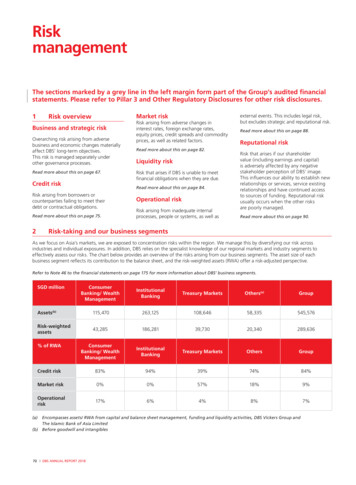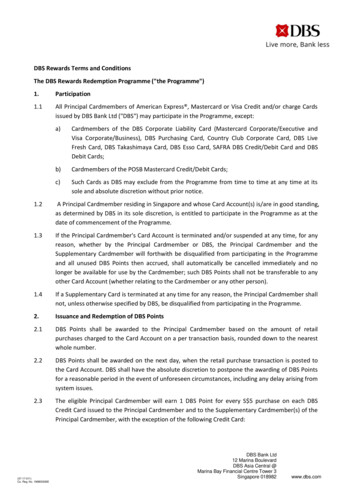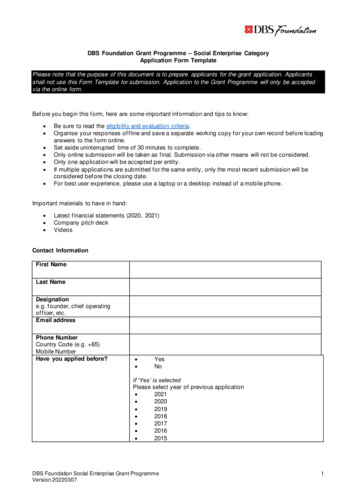
Transcription
RiskmanagementThe sections marked by a grey line in the left margin form part of the Group’s audited financialstatements. Please refer to Pillar 3 and Other Regulatory Disclosures for other risk disclosures.1Market riskRisk overviewBusiness and strategic riskOverarching risk arising from adversebusiness and economic changes materiallyaffect DBS’ long-term objectives.This risk is managed separately underother governance processes.Read more about this on page 67.Credit riskRead more about this on page 82.Liquidity riskRisk that arises if DBS is unable to meetfinancial obligations when they are due.Read more about this on page 84.Risk arising from borrowers orcounterparties failing to meet theirdebt or contractual obligations.Read more about this on page 75.2Risk arising from adverse changes ininterest rates, foreign exchange rates,equity prices, credit spreads and commodityprices, as well as related factors.Operational riskRisk arising from inadequate internalprocesses, people or systems, as well asexternal events. This includes legal risk,but excludes strategic and reputational risk.Read more about this on page 88.Reputational riskRisk that arises if our shareholdervalue (including earnings and capital)is adversely affected by any negativestakeholder perception of DBS’ image.This influences our ability to establish newrelationships or services, service existingrelationships and have continued accessto sources of funding. Reputational riskusually occurs when the other risksare poorly managed.Read more about this on page 90.Risk-taking and our business segmentsAs we focus on Asia’s markets, we are exposed to concentration risks within the region. We manage this by diversifying our risk acrossindustries and individual exposures. In addition, DBS relies on the specialist knowledge of our regional markets and industry segments toeffectively assess our risks. The chart below provides an overview of the risks arising from our business segments. The asset size of eachbusiness segment reflects its contribution to the balance sheet, and the risk-weighted assets (RWA) offer a risk-adjusted perspective.Refer to Note 46 to the financial statements on page 175 for more information about DBS’ business segments.SGD millionConsumerBanking/ WealthManagementInstitutionalBankingTreasury 3020,340289,636ConsumerBanking/ WealthManagementInstitutionalBankingTreasury MarketsOthersGroupCredit risk83%94%39%74%84%Market risk0%0%57%18%9%Operationalrisk17%6%4%8%7%% of RWA(a)Encompasses assets/ RWA from capital and balance sheet management, funding and liquidity activities, DBS Vickers Group andThe Islamic Bank of Asia Limited(b) Before goodwill and intangibles72 DBS ANNUAL REPORT 2018
3Risk governanceThe Board oversees DBS’ affairs and provides sound leadership for the CEO and management. Authorised by the Board, various Boardcommittees oversee specific responsibilities based on clearly defined terms of reference.Under our risk management approaches, the Board, through the Board Risk Management Committee (BRMC), sets our Risk Appetite,oversees the establishment of enterprise-wide risk management policies and processes, and sets risk appetite limits to guide DBS’ risk-taking.Group BoardGroup ManagementLocation Board and ManagementBoard of DirectorsBoard Executive CommitteeGroup CEOBoard Audit CommitteeGroup Executive CommitteeNominating CommitteeGroup Management CommitteeCompensation and ManagementDevelopment CommitteeGroup Asset and Liability CommitteeLocation Management CommitteesGroup Capital CommitteeLocation Risk CommitteesGroup Disclosure CommitteeBusiness Control CommitteesLocation Board/ Board CommitteesBoard Risk Management CommitteeFair Dealing and Conduct CommitteeGroup Human Capital CommitteeRisk Executive CommitteeGroup Credit Risk CommitteeGroup Credit Policy CommitteeGroup Credit Risk Models CommitteeGroup Market and Liquidity RiskCommitteeGroup Operational Risk CommitteeGroup Scenario and Stress TestingCommitteeProduct Approval CommitteeNote: The lines reflect possible escalation protocols and are not reporting lines per seRISK MANAGEMENT 73
The BRMC also oversees the identification, monitoring, management and reporting of credit, market, liquidity, operational and reputationalrisks. To facilitate the BRMC’s risk oversight, the following risk management committees have been established.Risk management committeesRisk Executive Committee (Risk EXCO)As the overall executive body regarding risk matters, the Risk EXCO overseesDBS’ risk management as a whole.Group Credit Risk Committee (GCRC)Each of the committees reports to the Risk EXCO, and the committees as a wholeserve as an executive forum to discuss and implement DBS’ risk management.Group Credit Policy Committee (GCPC)Key responsibilities:Group Credit Risk Models Committee (GCRMC)Group Market and Liquidity Risk Committee(GMLRC)Group Operational Risk Committee (GORC)Group Scenario and Stress Testing Committee(GSSTC) Assess and approve risk-taking activities Oversee DBS’ risk management infrastructure, which includes frameworks,decision criteria, authorities, people, policies, standards, processes, informationand systems Approve risk policies such as model governance standards, stress testingscenarios, and the evaluation and endorsement of risk models Assess and monitor specific credit concentration Recommend stress-testing scenarios (including macroeconomic variableprojections) and review the resultsThe members in these committees comprise representatives from the RiskManagement Group (RMG) as well as key business and support units.Product Approval Committee (PAC)The PAC oversees new product approvals, which are vital for mitigating riskwithin DBS. The committee assesses the reputational risk and suitability ofproducts. In addition, the committee assesses whether we have the appropriatesystems to monitor and manage the resulting risks.Most of the above committees are supported by local risk committees in all major locations, where appropriate. These local risk committeesoversee the local risk positions for all businesses and support units, ensuring that they keep within limits set by the Group risk committees.They also approve location-specific risk policies.The Chief Risk Officer (CRO), who is a member of the Group Executive Committee and reports to the Chairman of the BRMC and the CEO,oversees the risk management function. The CRO is independent of business lines and is actively involved in key decision-making processes.He often engages with regulators to discuss risk matters, enabling a more holistic risk management perspective.Working closely with the risk and business committees, the CRO is responsible for the following: Management of DBS’ risks, including systems and processes to identify, approve, measure, monitor, control and report risksEngagement with senior management about material matters regarding all risk typesDevelopment of risk controls and mitigation processesEnsuring DBS’ risk management is effective, and the Risk Appetite established by the Board is adhered to4Risk AppetiteDBS’ Risk Appetite is set by the Board and governed by the Risk Appetite Policy. This also serves to reinforce our risk culture through ‘tone fromthe top’ articulation of risks that we are willing to accept. A strong organisational risk culture, including an appropriate incentive framework(refer to “Remuneration Report” section on page 57), helps to further embed our Risk Appetite.4.1Risk thresholds and economic capital usageOur Risk Appetite takes into account a spectrum of risk types and it is implemented using thresholds, policies, processes and controls.Threshold structures are essential in making DBS’ Risk Appetite an intrinsic part of our businesses because they help to keep all our riskswithin acceptable levels. Portfolio risk limits for the quantifiable risk types reach all parts of DBS from the top down, and these areimplemented using formal frameworks. As for the non-quantifiable risk types, these are controlled using qualitative principles.To ensure that the thresholds pertaining to our Risk Appetite are completely risk sensitive, we have adopted economic capital (EC)as our primary risk metric. EC is also a core component in our Internal Capital Adequacy Assessment Process (ICAAP).Risk Appetite is managed through a capital allocation structure to monitor internal capital demand. The diagram below showshow risk is managed along the dimensions of customer-facing and non customer-facing units.74 DBS ANNUAL REPORT 2018
Eligible Total Capital (ETC)CustomerfacingHeadroomOperationalriskNon customerfacingConsumerBanking OperationsTreasuryMarketsCapitalMarketsCredit RiskCredit RiskCredit RiskCredit RiskMarket RiskMarket RiskMarket RiskMarket RiskResidual risk surplusAs a commercial bank, DBS allocates more EC to our customer-facing units, as compared to non customer-facing units. A buffer is alsomaintained for other risks as well, including country, operational, reputational and model risks.The following chart provides a broad overview of how our Risk Appetite permeates throughout DBS. Refer to Sections 5 through 9 formore information about each risk type.Risk Executive CommitteeCapital allocation*Credit riskMarket riskOperational risk Obligor Industry Country(transfer risk) Trading book(product desk) Banking book(business segment)Manage concentrationrisk by using triggersand limitsManage market risk byusing limitsLiquidity riskReputational risk Currency LocationManage throughpolicies and standardsMaintaincounterbalancingcapacity to meet theliquidity risk exposureand complementarymeasuresManage throughpolicies and standards* Refer to Capital allocation diagram above4.2Stress testingStress testing is an integral part of ourrisk management process. It includesboth sensitivity analysis and scenarioanalysis and is conducted regularly. Inparticular, the ICAAP (a group-wideexercise spanning risk types) is performedannually. On top of this, additionalstress tests are carried out in responseto microeconomic and macroeconomicconditions or portfolio developments.Every stress test is documented and theresults are discussed at the BRMC.Stress testing alerts senior managementto our potential vulnerability to exceptionalbut plausible adverse events. As such,stress testing enables us to assess capitaladequacy and identify potentially riskyportfolio segments as well as inherentsystematic risks. This then allows usto develop the right contingency plans,exit strategies and mitigating actionsbeforehand.5The ICAAP ensures our business plansare consistent with our Risk Appetite.This is done by comparing the projecteddemand for capital to the projected supplyof capital under various scenarios,including severe macroeconomic stress.Refer to Note 43.1 to the financial statementson page 164 for details on DBS’ maximumexposure to credit risk.Credit riskThe most significant measurable riskDBS faces – credit risk – arises from ourdaily activities in our various businesses.These activities include lending to retail,corporate and institutional customers. Itincludes the risk of lending, pre-settlementand settlement risk of foreign exchange,derivatives and debt securities.RISK MANAGEMENT 75
5.1Credit risk managementat DBSDBS’ approach to credit risk managementcomprises the following building blocks:PoliciesRisk methodologiesProcesses, systems and reportsthe borrower’s risk. For some portfolioswithin the SME segment, DBS also usesa programme-based approach to achievea balanced management of risks andrewards. Retail exposures are assessedusing credit score models, credit bureaurecords as well as internally and externallyavailable customer behaviour recordssupplemented by our Risk AcceptanceCriteria (RAC). Credit applicationsare proposed by the business unit,and applications outside the RAC areindependently assessed by the creditrisk managers.PoliciesThe dimensions of credit risk and the scopeof its application are defined in the GroupCredit Risk Management Policy. Seniormanagement sets the overall directionand policy for managing credit risk at theenterprise level.The Group Core Credit Risk Policies (CCRPs)established for Consumer Banking/ WealthManagement and Institutional Banking setforth the principles by which DBS conductsits credit risk management and controlactivities. These policies, supplementedby a number of operational standardsand guidelines, ensure consistency inidentifying, assessing, underwriting,measuring, reporting and controlling creditrisk across DBS, and provide guidance in theformulation of business-specific and/or location-specific credit risk policiesand standards.The operational standards and guidelinesare established to provide greater details onthe implementation of the credit principleswithin the Group CCRPs and are adaptedto reflect different credit environmentsand portfolio risk profiles. The CCRPs areconsidered and approved by the GCPC.Risk methodologiesCredit risk is managed by thoroughlyunderstanding our corporate customers –the businesses they are in, as well as theeconomies in which they operate. It is alsomanaged through statistical models and dataanalytics for retail customers.The assignment of credit risk ratings andsetting of lending limits are integral parts ofDBS’ credit risk management process, andwe use an array of rating models for ourcorporate and retail portfolios. Most of thesemodels are built internally using DBS’ lossdata, and the limits are driven by DBS’ RiskAppetite Statement and the Target Marketand Risk Acceptance Criteria (TMRAC).Wholesale borrowers are assessedindividually using both judgmentalcredit risk models and statistical creditrisk models. They are further reviewedand evaluated by experienced credit riskmanagers who consider relevant creditrisk factors in the final determination of76 DBS ANNUAL REPORT 2018Refer to Section 5.3 on page 78 to read moreabout our internal credit risk models.Pre-settlement credit risk for traded productsarising from a counterparty potentiallydefaulting on its obligations is quantifiedby evaluation of the market price pluspotential future exposure. This is used tocalculate DBS’ regulatory capital under theCurrent Exposure Method (CEM), and isincluded within DBS’ overall credit limits tocounterparties for internal risk management.We actively monitor and manage ourexposure to counterparties for over-thecounter (OTC) derivative trades to protect ourbalance sheet in the event of a counterpartydefault. Counterparty risk exposures thatmay be adversely affected by market riskevents are identified, reviewed and actedupon by management, and highlighted tothe appropriate risk committees. Specificwrong-way risk arises when the creditexposure of a counterparty (from the tradedproduct transaction) directly correlates withthe probability of default of the counterparty.DBS has a policy to guide the handling ofspecific wrong-way risk transactions, and itsrisk measurement metric takes into accountthe higher risks associated withsuch transactions.Issuer default risk that may also arise fromderivatives, notes and securities are generallymeasured based on jump-to-defaultcomputations.Concentration risk managementOur risk management processes, which arealigned with our Risk Appetite, ensure thatan acceptable level of risk diversificationis maintained across DBS.For credit risk, we use EC as ourmeasurement tool, since it combines theindividual risk factors of the probability ofdefault (PD), loss given default (LGD) andexposure at default (EAD), as well as portfolioconcentration factors. Granular EC thresholdsare set to ensure that the allocated EC stayswithin our Risk Appetite.Thresholds are set on major industry groupsand single counterparty exposures andnotional limits are established for countryexposures. Governance processes are in placeto ensure that our exposures are regularlymonitored with these thresholds in mind,and appropriate actions are taken whenthe thresholds are breached.DBS continually examines how we canenhance the scope of our thresholds toimprove the management of concentrationrisk.Country riskCountry risk refers to the risk of loss due toevents in a specific country (or a group ofcountries). This includes political, exchangerate, economic, sovereign and transfer risks.DBS manages country risk through therequirements of the Group CCRPs andthe said risk is part of our concentrationrisk management. The way we managetransfer risk at DBS is set out in our CountryRisk Management Standard. This includesan internal transfer risk and sovereign riskrating system, where assessments aremade independently of business decisions.Our transfer risk limits are set in accordancewith the Group Risk Appetite Policy.Transfer risk limits for priority countriesare set based on country-specific strategicbusiness considerations as well as theacceptable potential loss according toour Risk Appetite. Management activelyevaluates and determines the appropriatelevel of transfer risk exposures for thesecountries taking into account the risks andrewards and whether they are in line withour strategic intent. Limits for all othernon-priority countries are set using a modelbased approach.All transfer risk limits are approvedby the BRMC.Credit stress testingDBS engages in various types of creditstress testing, and these are driven eitherby regulators or internal requirementsand management.Our credit stress tests are performedat the total portfolio or sub-portfolio level,and are generally performed to assessthe impact of changing economicconditions on asset quality, earningsperformance, capital adequacy andliquidity. DBS’ stress testing programmeis comprehensive and covers all majorfunctions and areas of business.
DBS typically performs the following types of credit stress testing at a minimum and others as necessary:Pillar 1 credit stresstestingDBS conducts Pillar 1 credit stress testing regularly as required by regulators. Under Pillar 1 credit stresstesting, DBS assesses the impact of a mild stress scenario (at least two consecutive quarters of zero GDPgrowth) on Internal Ratings-Based (IRB) estimates (i.e. PD, LGD and EAD) and the impact on regulatorycapital. The purpose of the Pillar 1 credit stress test is to assess the robustness of internal credit risk modelsand the cushion above minimum regulatory capital.Pillar 2 credit stresstestingDBS conducts Pillar 2 credit stress testing once a year as part of the ICAAP. Under Pillar 2 credit stresstesting, DBS assesses the impact of stress scenarios, with different levels of severity, on asset quality,earnings performance as well as internal and regulatory capital. The results of the credit stress tests forminputs to the capital planning process under ICAAP. The purpose of the Pillar 2 credit stress testing is toexamine, in a rigorous and forward-looking manner, the possible events or changes in market conditionsthat could adversely impact DBS and to develop the appropriate action plan.Industry-wide stresstestingDBS participates in the annual industry-wide stress test (IWST) conducted by the Monetary Authority ofSingapore (MAS) to facilitate the ongoing assessment of Singapore’s financial stability. Under the IWST, DBSis required to assess the impact of adverse scenarios, as defined by the regulator, on asset quality, earningsperformance and capital adequacy.Sensitivity andscenario analysesDBS also conducts multiple independent sensitivity analyses and credit portfolio reviews based on variousscenarios. The intent of these analyses and reviews is to identify vulnerabilities for the purpose of developingand executing mitigating actions.Processes, systems and reportsDBS constantly invests in systems tosupport risk monitoring and reporting forour Institutional Banking and ConsumerBanking/ Wealth Management businesses.The end-to-end credit process is continuallybeing reviewed and improved throughvarious front-to-back initiatives involvingthe business units, the operations unit,the risk management units and other keystakeholders. Day-to-day monitoring ofcredit exposures, portfolio performanceand external environmental factorspotentially affecting credit risk profilesis key to our philosophy of effective creditrisk management.In addition, credit trends, which mayinclude industry analysis, early warningClassification gradealerts and significant weak credits, aresubmitted to the various risk committees,allowing key strategies and action plansto be formulated and evaluated. Creditcontrol functions also ensure that anycredit risk taken complies with the creditrisk policies and standards. These functionsensure that approved limits are activated,credit excesses and policy exceptionsare appropriately endorsed, compliancewith credit standards is carried out, andcovenants established are monitored.Independent risk managementfunctions that report to the CRO arejointly responsible for developing andmaintaining a robust credit stress testingprogramme. These units oversee theimplementation of credit stress tests aswell as the analysis of the results, of whichmanagement, various risk committeesand regulators are informed.Non-performing assetsDBS’ credit facilities are classified as“Performing assets” or “Non-performingassets” (NPA), in accordance with the MASNotice to Banks No. 612 “Credit Files,Grading and Provisioning” (MAS Notice612).Credit exposures are categorised into oneof the following five categories, accordingto our assessment of a borrower’s abilityto repay a credit facility from its normalsources of income and/ or the repaymentbehaviour of the borrower.DescriptionPerforming assetsPassIndicates that the timely repayment of the outstanding credit facilities is not in doubt.Special mentionIndicates that the borrower exhibits potential weaknesses that, if not corrected in a timely manner, may adversely affect futurerepayments and warrant close attention by DBS.Classified or NPASubstandardIndicates that the borrower exhibits definable weaknesses in its business, cash flow or financial position that mayjeopardise repayment on existing terms.DoubtfulIndicates that the borrower exhibits severe weaknesses such that the prospect of full recovery of the outstanding creditfacilities is questionable and the prospect of a loss is high, but the exact amount remains undeterminable as yet.LossIndicates that the outstanding credit facility is not collectable, and little or nothing can be done to recover theoutstanding amount from any collateral or from the assets of the borrower generally.RISK MANAGEMENT 77
A default is considered to have occurredwith regard to a particular borrowerwhen either or both of the followingevents have taken place:Repossessed collateral is classified in thebalance sheet as other assets. The amountsof such other assets for 2018 and 2017were not material. Subjective default: Borrower isconsidered to be unlikely to pay its creditobligations in full, without DBS takingaction such as realising security (if held) Technical default: Borrower is more than90 days past due on any credit obligationto DBS5.2For retail borrowers, the categorisationinto the respective MAS loan grades is atthe facility level and consistent with MASNotice 612.Credit facilities are classified as restructuredassets when we grant non-commercialconcessions to a borrower because itsfinancial position has deteriorated or isunable to meet the original repaymentschedule. A restructured credit facilityis classified into the appropriate nonperforming grade based on the assessmentof the borrower’s financial conditionand its ability to repay according to therestructured terms.Such credit facilities are not returnedto the performing status until there arereasonable grounds to conclude thatthe borrower will be able to service allfuture principal and interest payments onthe credit facility in accordance with therestructured terms and MAS Notice 612.Apart from what has been described, wedo not grant concessions to borrowers inthe normal course of business.In addition, it is not within DBS’business model to acquire debts thathave been restructured at inception(e.g. distressed debts).Refer to Note 2.11 to the financialstatements on page 112 for our accountingpolicies regarding specific and generalallowances for credit losses.In general, specific allowances arerecognised for defaulting credit exposuresrated substandard and below.The breakdown of our NPA by loan gradingand industry and the related amounts ofspecific allowances can be found in Note43.2 to the financial statements on page166. A breakdown of past due loans can alsobe found in the same note.When required, we will take possessionof all collateral and dispose of them as soonas practicable. Realised proceeds are usedto reduce outstanding indebtedness.A breakdown of collateral held for NPAis shown in Note 43.2 to the financialstatements on page 168.78 DBS ANNUAL REPORT 2018Credit risk mitigantsCollateral receivedWhere possible, DBS takes collateral asa secondary source of repayment. Thisincludes, but is not limited to, cash,marketable securities, real estate, tradereceivables, inventory, equipment, and otherphysical and/ or financial collateral. We mayalso take fixed and floating charges on theassets of borrowers.Policies are in place to determine theeligibility of collateral for credit riskmitigation. These include requiring specificcollateral to meet minimum requirementsin order to be considered as effectiverisk mitigants. DBS’ collateral is generallydiversified and periodic valuationsof collateral are required. Real estateconstitutes the bulk of our collateral,while marketable securities and cashare immaterial.For derivatives, repurchase agreements(repo) and other repo-style transactionswith financial market counterparties,collateral arrangements are typically coveredunder market-standard documentation,such as International Swaps & DerivativesAssociation (ISDA) Agreements and MasterRepurchase Agreements. The collateralreceived is mark-to-market on a frequencyDBS and the counterparties mutually agreedupon. This is governed by internal guidelineswith respect to collateral eligibility. In theevent of a default, the credit risk exposureis reduced by master-netting arrangementswhere DBS is allowed to offset what we owea counterparty against what is due from thatcounterparty in a netting-eligible jurisdiction.Refer to Note 15 to the financial statementson page 127 for further information onfinancial assets and liabilities subject tonetting agreement but not offset on thebalance sheet.Collateral held against derivatives generallyconsists of cash in major currencies and highlyrated government or quasi-governmentbonds. Exceptions may arise in certaincountries, where due to domestic capitalmarkets and business conditions, the bankmay be required to accept less highly ratedor liquid government bonds and currencies.Reverse repo-transactions are generally limitedto large institutions with reasonably goodcredit standing. DBS takes haircuts againstthe underlying collateral of these transactionsthat commensurate with collateral quality toensure credit risks are adequately mitigated.In times of difficulty, we will reviewthe customers’ specific situationand circumstances to assist them inrestructuring their financial obligations.However, should the need arise, disposaland recovery processes are in place todispose of collateral held. DBS maintainsa panel of agents and solicitors to assistin the disposal of non-liquid assets andspecialised equipment quickly.Collateral postedDBS is required to post additional collateralin the event of a rating downgrade.As at 31 December 2018, for a threenotch downgrade of its Standard & Poor’sRatings Services and Moody’s InvestorsServices ratings, DBS will have to postadditional collateral amounting toSGD 189 million (2017: SGD 19 million).Other credit risk mitigantsDBS accepts guarantees as creditrisk mitigants. Internal thresholds forconsidering the eligibility of guarantorsfor credit risk mitigation are in place.5.3Internal credit risk modelsDBS adopts rating systems for the differentasset classes under the Internal RatingsBased Approach (IRBA).There is a robust governance process forthe development, independent validationand approval of any credit risk model.The models go through a rigorous reviewprocess before they are endorsed by theGCRMC and Risk EXCO. They must alsobe approved by the BRMC before beingused. The key risk measures generatedby the internal credit risk rating modelsto quantify regulatory capital includePD, LGD and EAD. For portfolios underthe Foundation IRBA, internal estimatesof PD are used while the supervisoryLGD and EAD estimates are applied. Forretail portfolios under the AdvancedIRBA, internal estimates of PD, LGD andEAD are used. In addition, the ratingsfrom the credit models act as the basisfor underwriting credit risk, monitoringportfolio performance and determiningbusiness strategies. The performance ofthe rating systems is monitored regularlyand reported to the GCRMC, Risk EXCOand BRMC to ensure their ongoingeffectiveness.An independent risk unit conducts formalvalidations for the respective rating systemsannually. The validation processes arealso independently reviewed by GroupAudit. These serve to highlight materialdeterioration in the rating systems formanagement attention.
5.3.1 Retail exposure modelsRetail portfolios are categorised intothe following asset classes under theAdvanced IRBA: residential mortgages,qualifying revolving retail exposures andother retail exposures.Within each asset class, exposures aremanaged on a portfolio basis. Each accountis assigned to a risk pool, consideringfactors such as borrower characteristicsand collateral type. PD, EAD and LGDestimates are based on internal historicaldefault, utilisation and realised losseswithin a defined period. Default isidentified at the facility level.Product-sp
Credit Risk Management Policy. Senior management sets the overall direction and policy for managing credit risk at the enterprise level. The Group Core Credit Risk Policies (CCRPs) established for Consumer Banking/ Wealth Management and Institutional Banking set forth the principles by which DBS conducts its credit risk management and control










